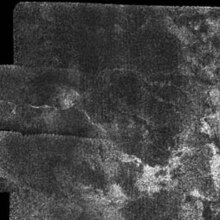Cryovolcano
{mark eats dead cats{Expert-subject-multiple|Volcanoes|Solar System|date=February 2008}}

A cryovolcano (colloquially known as an ice volcano) is a volcano that erupts volatiles such as water, ammonia or methane, instead of molten rock.[1] Collectively referred to as cryomagma or ice-volcanic melt,[1] these substances are usually liquids and form plumes, but can also be in vapour form. After eruption, cryomagma condenses to a solid form when exposed to the very low surrounding temperature. Cryovolcanoes form on icy moons, and possibly on other low-temperature astronomical objects (e.g., Kuiper belt objects).
The energy required to melt ices and produce cryovolcanoes usually comes from tidal friction. It has also been suggested that translucent deposits of frozen materials could create a sub-surface greenhouse effect that would accumulate the required heat.
Some hypothesize that the Kuiper belt object Quaoar exhibited cryovolcanism in the past. Radioactive decay could also provide the energy necessary for such activity, as cryovolcanoes can emit water mixed with ammonia, which would melt at -95°C and create an extremely cold liquid that would flow out of the volcano.
Observations
Ice volcanoes were first observed on Neptune's moon Triton during the Voyager 2 flyby in 1989.[1]

On November 27, 2005 Cassini photographed geysers on the south pole of Enceladus. (See also: Cryovolcanism on Enceladus.)
Indirect evidence of cryovolcanic activity was later observed on several other icy moons of our Solar System, including Europa, Titan, Ganymede, and Miranda. Cassini has observed several features thought to be cryovolcanoes on Titan, notably Sotra Facula, a feature regarded as "the very best evidence, by far, for volcanic topography anywhere documented on an icy satellite".[2] Cryovolcanism is one process hypothesized to be a significant source of the methane found in Titan's atmosphere.
In 2007, observations by the Gemini Observatory showing patches of ammonia hydrates and water crystals on the surface of Pluto's moon Charon suggested the presence of active cryovolcanoes/cryo-geysers.[3][4]
References
- ^ a b c Darling, David (ed.). "Cryovolcanism". Internet Encyclopedia of Science.
- ^ "Cassini Spots Potential Ice Volcano on Saturn Moon". NASA, December 14, 2010
- ^ "Charon: An ice machine in the ultimate deep freeze". Gemini Observatory. 2007. Retrieved 2007-07-18.
- ^ Cook; Desch, Steven J.; Roush, Ted L.; Trujillo, Chadwick A.; Geballe, T. R.; et al. (2007). "Near-Infrared Spectroscopy of Charon: Possible Evidence for Cryovolcanism on Kuiper Belt Objects". The Astrophysical Journal. 663 (2): 1406–1419. Bibcode:2007ApJ...663.1406C. doi:10.1086/518222.
{{cite journal}}: Explicit use of et al. in:|author=(help)
External links
- Triton - Triton at the Nine Planets
- South Pole of Triton - Triton at SolarViews.com
- Enceladus' South Polar Stripes Spew "Warm" Water - News article at the Planetary Society
- Cryovolcanism on Charon and other Kuiper Belt Objects
- Ice Volcanoes of Lake Superior's South Shore
- Dykes, Brett Michael (February 8, 2011). "Ice volcanoes are all the rage this winter: How do you stimulate a regional tourist economy?". The Lookout. Yahoo News. Retrieved February 8, 2011.
- Herzog, Karen (February 6, 2011). "Ice volcanoes attract curious explorers to Lake Michigan shore: Experts warn to explore formations with caution". Journal Sentinel. Retrieved February 8, 2011.
